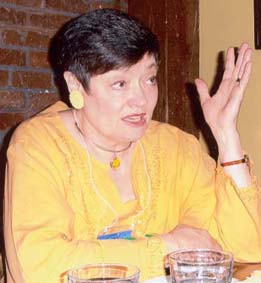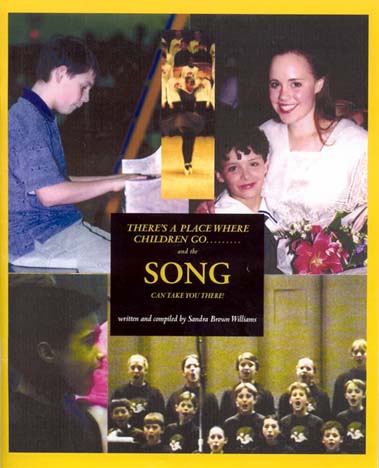Sandra Brown Williams |
Writer/Philosopher
Sandra's most recent published article is in the November 2006 issue of the Choral Journal , Official Publication of the American Choral Directors Association. Volume 47, No. 5
|
The song is mine, the song is yours. - Sandra Brown Williams |
There's a Place Where Children Go, |
Written and compiled by
|
Jimbo, the Highway PhilosopherSandra Brown Williams, Oregon President Northwest Notes We pulled into the Deli Mart 2 on U.S. Highway 287 in Decatur, Texas. At halfway through the 5,500 mile road trip my husband and I took this summer, we had begun to compare filling stations and rest stops. I noticed an older man on a ladder cleaning the windows. Once inside, it became apparent someone cared about the place. When the older man came into the store, I asked, "Are you the one who keeps this place looking so clean?" His immediate response was, "Do what you are interested in. I am interested in this place, so I do it. If you are not interested, you won't do it." I listened. He then said, "Do what you need to do first. Do not start with your wants If you begin with your wants, when you get there, you will feel empty." He then went on with his cleaning. As I was leaving I spoke to him again outside. He said without any prompting, "I try to take care of myself first, then I can take care of other people. Life can be hard, but you have to go through the valley. A lot of folks try to go around the valley and avoid it, but you got to go through it." Then he began singing an original version of "You've got to go through the valley." It was beautiful. He was beautiful. I introduced myself, and my husband. He responded, "My name is Jim, but they call me Jimbo." He let me take his picture and I hoped it would turn out, knowing it is difficult to capture angels on film. It did turn out, and I am sending one framed to him. He had said, "I did have a picture taken one time." As we pulled out, this wonderful eighty-year old man was back up on the ladder cleaning the windows and singing. As conductors, we are interested in what we do. We have chosen this profession. We go to workshops to learn specific techniques and procedures that will help our students sing more beautifully, count more accurately, and understand more about the historical significance and harmonic structure of music. In the end, do our students appear interested in what they are singing? Is the audience captivated by an infectious interest on the part of the choir. Speaking with Jimbo reminded me of a college professor who asked the question, "At what point does the pitcher begin to throw the ball?" He led the class into realizing that the ball actually leaving the hand was late in the process of throwing. The interest and focus of our students should be apparent long before they sing. When Jimbo began his song in the midst of his dialogue, it was not a surprise. It seemed incredibly natural and appropriate. His understanding of what he spoke was so profound that his music made sense. The style was good because it was real. He communicated exactly what he wanted to communicate. In an effort to address this interest and readiness in singing, I have changed my rehearsal process over the last few years. The students learn that the rehearsal begins as they first enter the room, and it begins without me. They must find the energy from within themselves and must be willing to relate to the energy of other members of the choir. Of course, they have to be reminded almost every rehearsal, but each time they are more relaxed and more willing to take the risk of trusting themselves to be a vital and important part of the rehearsal process. First, I have them walk randomly around the room. They are asked to smile as they pass other choir members. The smile should be real. If they feel ill or sad, they are encouraged to come and tell me at that time. Otherwise, they are expected to find the joy in seeing their colleagues. They begin vocal and physical warm ups on their own. We have learned vocal warm ups in previous rehearsals. They should know their own voices well enough to know what works best. I listen and watch each member, even though I am often engaged in the final preparation of preparing the room for the rehearsal. If I have a concern, I ask them to stop moving and singing and give further instructions. The instructions are layered, becoming more specific and complex with each direction. Students are asked to do more than one thing at a time. Singing is dimensional. They are asked to look pleasant during this warm up time. The joyful and vibrant face must greet the printed page. The response of appearing interested has to be learned. The group progresses to less independent movements and vocalizations until we come together as a group. I find that these exercises release tensions brought from outside the rehearsal room; they demonstrate that I trust and value each individual; they allow the group to smile and greet one another, and all members of the choir relate to one another rather than to just a select group of personal friends. The director is now ready to work on the needs of the choir. Both the director and the students determine these needs. The students are asked which sections of the music are the most problematic. They are asked why the section is problematic. The students are engaged in the rehearsal process. The students are valued for their ability to ascertain the needs of the choir, and those who are lost begin to wonder with awe how some students know the problematic sections, and so they become more interested. By working on the needs of the choir, we can achieve the common "want" of desiring to have a choir that sings and communicates beautifully. It is so tempting for us to avoid facing our particular areas of weakness. It is encouraging to know that within a choir the individual strengths can be used to help others who are weaker. As the director, I rely on the strengths of my students. If, however, I have a weakness that consistently surfaces, it must be addressed. As Jimbo said, "First you take care of yourself and then you can take care of others." |

A Proclamation Concerning Teaching the Middle Level Choral Student!
Sandra Brown Williams
Oregon President (2003)
Northwest Notes
Spring, 2003, Volume XI, No. 3
The dictionary defines the word proclaim as making known by announcing in a public place . A proclamation is that of a public notice given by an official of some order, or an intended action . I may never have a more official position than President of Oregon ACDA. I may never have a more public place than Northwest Notes. Therefore, I intend to make a proclamation.
I do not think that middle level teaching will advance to a consistently high level until we stop perpetuating stereotypes of the middle level student and the middle level teacher. Do we not hear jokes about what it is like to teach at the middle level? Do we not hear our own choral colleagues make inappropriate comments? For the last few years I have saved articles from professional publications that are specifically about teaching middle school. The articles were excellent, but the titles imply and perpetuate an expectation that there will be trouble or impending failure at the middle level. Would we expect to see such titles about musicians of any other age? No, we mostly read about techniques for teaching without a wrapping of negativity. Specific qualifications in skills and personality are required for the uniqueness at every age level
The ProclamationMiddle level students need to be taught to sing well as individuals and ensemble members. They need to learn how to rehearse, how to count, how to breathe, how to read music, how to have joy, how to listen, and how to have artistry in performance. Middle level teachers are the most informed about how we might affect the future for middle level students. We should set goals and network to achieve the goals. We cannot change the natural maturation and growth process of middle level students, and we do not want to. We can become more knowledgeable about behavioral development, literature, vocal ranges, and the voice. Middle level teachers should encourage and support composers and publishers who provide appropriate literature, and middle level teachers should be helpful by sharing specific suggestions to composers and publishers. Middle level teachers and choral colleagues should eliminate any comments or references to middle level students that are detrimental and could not be said in the presence of the middle level students. Middle level teachers should redefine who we are by setting higher standards in choral musicianship and effective teaching methods.
|
I have come to believe that our strength will be in our understanding and knowledge of the voice. Even in the midst of fluctuating enrollments and teaching assignments, any child has a curiosity about the voice. My own history included having very large choirs at the middle level. Using the energy of a choir that became popular at the school, more singers were attracted and enthused about singing. Extensive trips and competitive events were possible and exciting. Since opening the Regional Institute for the Teaching of Singing and working more with small groups and individual voices, I am pleased to rediscover that the individual attention and nurturing that happens in smaller ensembles is equally exciting. We can teach very competently in a variety of settings with a variety of voices. Certainly the work in these small groups is having a profound influence on my work with larger groups. In fact, my new motto is to teach from the inside out . Regardless of the structure in which we teach, we can commit ourselves to teaching students to sing well, we can share our knowledge and experience, and we can continue to learn about how to teach that miraculous and complex wonder called, the voice.
Sandra Brown Williams |

